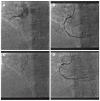Preliminary experience with drug-coated balloon angioplasty in primary percutaneous coronary intervention
- PMID: 26131335
- PMCID: PMC4478565
- DOI: 10.4330/wjc.v7.i6.311
Preliminary experience with drug-coated balloon angioplasty in primary percutaneous coronary intervention
Abstract
We evaluated the clinical feasibility of using drug-coated balloon (DCB) angioplasty in patients undergoing primary percutaneous coronary intervention (PPCI). Between January 2010 to September 2014, 89 ST-elevation myocardial infarction patients (83% male, mean age 59 ± 14 years) with a total of 89 coronary lesions were treated with DCB during PPCI. Clinical outcomes are reported at 30 d follow-up. Left anterior descending artery was the most common target vessel for PCI (37%). Twenty-eight percent of the patients had underlying diabetes mellitus. Mean left ventricular ejection fraction was 44% ± 11%. DCB-only PCI was the predominant approach (96%) with the remaining 4% of patients receiving bail-out stenting. Thrombolysis in Myocardial Infarction (TIMI) 3 flow was successfully restored in 98% of patients. An average of 1.2 ± 0.5 DCB were used per patient, with mean DCB diameter of 2.6 ± 0.5 mm and average length of 23.2 ± 10.2 mm. At 30-d follow-up, there were 4 deaths (4.5%). No patients experienced abrupt closure of the infarct-related artery and there was no reported target-lesion failure. Our preliminary experience showed that DCB angioplasty in PPCI was feasible and associated with a high rate of TIMI 3 flow and low 30-d ischaemic event.
Keywords: Acute myocardial infarction; Drug coated balloon; Efficacy; Primary angioplasty; Safety.
Figures

References
-
- Keeley EC, Boura JA, Grines CL. Primary angioplasty versus intravenous thrombolytic therapy for acute myocardial infarction: a quantitative review of 23 randomised trials. Lancet. 2003;361:13–20. - PubMed
-
- Grines CL, Cox DA, Stone GW, Garcia E, Mattos LA, Giambartolomei A, Brodie BR, Madonna O, Eijgelshoven M, Lansky AJ, et al. Coronary angioplasty with or without stent implantation for acute myocardial infarction. Stent Primary Angioplasty in Myocardial Infarction Study Group. N Engl J Med. 1999;341:1949–1956. - PubMed
-
- Stone GW, Grines CL, Cox DA, Garcia E, Tcheng JE, Griffin JJ, Guagliumi G, Stuckey T, Turco M, Carroll JD, et al. Comparison of angioplasty with stenting, with or without abciximab, in acute myocardial infarction. N Engl J Med. 2002;346:957–966. - PubMed
-
- Stone GW, Lansky AJ, Pocock SJ, Gersh BJ, Dangas G, Wong SC, Witzenbichler B, Guagliumi G, Peruga JZ, Brodie BR, et al. Paclitaxel-eluting stents versus bare-metal stents in acute myocardial infarction. N Engl J Med. 2009;360:1946–1959. - PubMed
-
- Cox DA, Stone GW, Grines CL, Stuckey T, Cohen DJ, Tcheng JE, Garcia E, Guagliumi G, Iwaoka RS, Fahy M, et al. Outcomes of optimal or “stent-like”balloon angioplasty in acutemyocardial infarction: the CADILLAC trial. J Am Coll Cardiol. 2003;42:971–977. - PubMed
Publication types
LinkOut - more resources
Full Text Sources
Other Literature Sources
Miscellaneous

